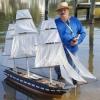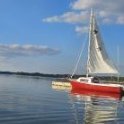Supplies of the Ship Modeler's Handbook are running out. Get your copy NOW before they are gone! Click on photo to order.
×
-
Posts
871 -
Joined
-
Last visited
Reputation Activity
-
 JerryTodd got a reaction from mtaylor in Pride of Baltimore by JerryTodd - 1:20 scale - RADIO - as she appeared in Fall 1981
JerryTodd got a reaction from mtaylor in Pride of Baltimore by JerryTodd - 1:20 scale - RADIO - as she appeared in Fall 1981
Winter, as handling epoxy in an unheated garage matters, seemed to last almost till the end of April.
But finally the temperatures and my time have coincided enough that I may finally get this ostrich egg finished.
It seems the plastic egg deformed a little from the weight, so the two halves don't lay flat to each other. If I do this again, and for you folks thinking of using this method, I will put ribs inside the bulb to stiffen it, and fashion some sort of cradle to sit on that supports it so the bulb doesn't try to flatten out as the epoxy and lead set-up.
There were also pockets in the bulb that resin hadn't gotten to and I could hear the shot rattling around inside. If there's a next time, I'll mix shot and resin separately and pour the mix into the bulb.
What sounded like the biggest of these pockets was behind the flange? I modeled in for the plate to slide into. I opened the holes here to pour more resin in and hopefully fill this void.
I re-drilled to holes for the pin that will keep the bulb from sliding off the plate, and cut about a 3 inch length of 3/16" brass rod for the pin.
I mixed very fine sawdust from my band-saw with the epoxy to make a paste of it, and buttered both sides of the bulb, placed the pin, and plate, and put the other half on.
I used a sliver of wood as a wedge in the bottom seam to push the seam on top, where the plate enters, as closed as I could, making something of a gap at the bottom. The epoxy butter filled this in fairly well, but the seam's open almost all the way around, which I'll fill with more epoxy butter.
The bulb also needs some clean-up from epoxy runs and cardboard that stuck to it; and I intend to wrap it in glass cloth as that'll be stronger than the resin alone if the boat should hit a rock or something.
-
 JerryTodd got a reaction from GrandpaPhil in Pride of Baltimore by JerryTodd - 1:20 scale - RADIO - as she appeared in Fall 1981
JerryTodd got a reaction from GrandpaPhil in Pride of Baltimore by JerryTodd - 1:20 scale - RADIO - as she appeared in Fall 1981
Winter, as handling epoxy in an unheated garage matters, seemed to last almost till the end of April.
But finally the temperatures and my time have coincided enough that I may finally get this ostrich egg finished.
It seems the plastic egg deformed a little from the weight, so the two halves don't lay flat to each other. If I do this again, and for you folks thinking of using this method, I will put ribs inside the bulb to stiffen it, and fashion some sort of cradle to sit on that supports it so the bulb doesn't try to flatten out as the epoxy and lead set-up.
There were also pockets in the bulb that resin hadn't gotten to and I could hear the shot rattling around inside. If there's a next time, I'll mix shot and resin separately and pour the mix into the bulb.
What sounded like the biggest of these pockets was behind the flange? I modeled in for the plate to slide into. I opened the holes here to pour more resin in and hopefully fill this void.
I re-drilled to holes for the pin that will keep the bulb from sliding off the plate, and cut about a 3 inch length of 3/16" brass rod for the pin.
I mixed very fine sawdust from my band-saw with the epoxy to make a paste of it, and buttered both sides of the bulb, placed the pin, and plate, and put the other half on.
I used a sliver of wood as a wedge in the bottom seam to push the seam on top, where the plate enters, as closed as I could, making something of a gap at the bottom. The epoxy butter filled this in fairly well, but the seam's open almost all the way around, which I'll fill with more epoxy butter.
The bulb also needs some clean-up from epoxy runs and cardboard that stuck to it; and I intend to wrap it in glass cloth as that'll be stronger than the resin alone if the boat should hit a rock or something.
-
 JerryTodd got a reaction from KeithAug in Pride of Baltimore by JerryTodd - 1:20 scale - RADIO - as she appeared in Fall 1981
JerryTodd got a reaction from KeithAug in Pride of Baltimore by JerryTodd - 1:20 scale - RADIO - as she appeared in Fall 1981
The paint dry, things can be put in their places to check fit and alignments.
Then on to the forward winch-tray.
Reusing the blocks that were epoxied in for the rudder to sit on, I needed them taller and the angle change so the plane of this tray is level with the one aft. I also need them a little longer because this tray will get slots cut into it so I can adjust it fore-and-aft to set the tension on the loop, and so the screw that hold it are accessible through the hatch.
The battery lays just aft of here as well, so I shaped the pieces like knees to over hang it a little while not interfering with access to it. The added pieces are glued to the old rudder-servo mounts, but not having a good way to clamp them, I put a couple of bugle-head screws in, which I think I'll leave in there, since they're epoxy coated.
Here's a pic of the model with sub-deck laid in to show the access hatch openings as they'll be in the finished model. The little hatch forward will most likely get decked over when the time comes as it's not really for anything.
The "engine room hatch" over the aft winch and the main hatch will be screwed down with rubber gaskets to prevent leakage since I expect this boat to be as wet as the real one was.
-
 JerryTodd reacted to archjofo in La Créole 1827 by archjofo - Scale 1/48 - French corvette
JerryTodd reacted to archjofo in La Créole 1827 by archjofo - Scale 1/48 - French corvette
@Thukydides
Thank you for your nice comment, and everyone else for the many LIKES.
Equipment of the main royal yard – Vergue de grand cacatois
The royal yards are on the 4th floor of the rigging. Since these yards on the La Créole were obviously equipped with lifts and braces, it can be assumed that they were already an integral part of the ship's rigging. In contrast, until the end of the 18th century, the royal sails were often hoisted together with the yards and flown as fair-weather sails only when necessary, i.e. without braces and lifts.
To carry out the tyes for the royal yards of La Créole, I have photos of the original model at my disposal, which a restorer from the Musée de la Marine in Paris kindly photographed in the depot especially for me.
You can't see much in the following picture of a royal yard of the Paris model, except that the tye is somehow knotted and doesn't have a hook like that of the togallant yards.
Source: Musée national de la Marine de Paris – La Créole
Source: Atlas du Génie Maritime
In conjunction with the depiction of a royal yard from the Atlas du Génie Maritime and various other examples, the tyes may have looked like this.
My model implementation or interpretation of the tye ø 17 mm (ø 0.35 mm in model scale) for the main royal yard looks like this:
Next I made the parral. The royal yards receive a slightly simpler version of a parral, only served with ropes, without leather covering.
This was followed by the production of the single blocks for the royal yards. These were used to guide the clew lines - The clew lines for the main royal sail had a diameter of 11 mm (in the model scale ø 0.23 mm), accordingly the blocks were around 13.5 cm long (in the model scale approx. 2.8 mm) according to the table in the monograph .
After attaching the grommets as abrasion protection, the equipment of the main royal yard was completed by attaching the braces and lifts.
We then continue with the fore royal yard.
Sequel follows …
-
 JerryTodd reacted to dafi in HMS Victory by dafi - Heller - PLASTIC - To Victory and beyond ...
JerryTodd reacted to dafi in HMS Victory by dafi - Heller - PLASTIC - To Victory and beyond ...
The next adventure and small intermezzo were the blocks under the fore fighting top. Here, leech- and buntline run colorfully mixed with the braces of the sprite sail yard and top yard through a wonderful collection of blocks.
The first attempt was the classic way of doing the strop first ...
... and then pull it through to the top from below and push the toggle through the upper loop.
It worked, but it was a rather messy and uneven act.
Then prepared another block, but didn't tie the top loop ...
... and pushed the free end from the bottom to the top, tied a loop there with an auxiliary thread and brought the free end back down.
Now I was able to pull the loop at the top tight from below, insert the toggle and adjust the length with the free ends of the binding, knot everything and neaten the whole thing.
It looks much better http://www.shipmodels.info/mws_forum/images/smilies/icon_smile.gif
You can see the 3 different blocks, with the outer one having two differently sized wheels.
This is due to the fact that there are four rope thicknesses in use at this point, resulting in simply beautiful details.
And it also looks very tidy from above.
And if one wonders about the different layout of the battens, very simple: the Admirality Order from 20. Nov.1802 defines the tops of great ships to be done out of fir instead of oak and to be fitted in two halves http://www.shipmodels.info/mws_forum/images/smilies/icon_smile.gif
This made the tops less haevy and far more easy to be exchanged if damaged.
Yay!
XXXDAn
-
 JerryTodd reacted to dafi in HMS Victory by dafi - Heller - PLASTIC - To Victory and beyond ...
JerryTodd reacted to dafi in HMS Victory by dafi - Heller - PLASTIC - To Victory and beyond ...
The main yard was finally also finished so far, here is an overview of the collection of all the blocks that have now snuggled together. Always seen from both the front and the aft. And as already written earlier, the stirrups and foot horses will only be smoothed and provided with gravity during the final installation.
The center of the yard with the chain sling ...
... and the yard arm, 9 blocks in 8 sizes :-0
Then came the exciting moment, the test hanging http://www.shipmodels.info/mws_forum/images/smilies/icon_smile.gif
First the lifts.
Then the yard tackles with outer tricing line.
And usually as last the braces.
And there is another little tidbit that is not normally seen on models. According to Steel, the rope slings were replaced by chain slings in wartime, as can be seen in the pictures of the lifts. Consequently, the forward-facing preventer braces should also be fitted. These replaced the double pendant of the braces of the 1760s. For this purpose, the brace was attached to the rearmost shroud of the foremast, ran to a block on the front of the yard, back to a block on the rearmost shroud and from there to the forecastle.
Exciting.
XXXDAn
-
 JerryTodd got a reaction from GrandpaPhil in 3D Naval Guns 1850s ~ 1870s
JerryTodd got a reaction from GrandpaPhil in 3D Naval Guns 1850s ~ 1870s
Someone over in Deven, England needed a pair of 2-banded Brooke rifls for a 1:48 scale model of the Confederate ironclad Neuse.
I hadn't printed either of the Brookes as yet, so I soon discovered some bits were missing, ie, I forgot to mirror a part to the other side of the gun, actually, just the slide.
I fixed the STL on Thingiverse, but to fix the already printed models, I printed that part and a couple of eye-bolts separately, attached them to the models with resin zapped with UV light.
They're carefully packed and off to England, making me an International Arms Dealer It's very expensive shipping a 95 gram box to the UK from the US, over $30 USD in fact, but he was adamant there was no one local to 3D print them for him.
-
 JerryTodd got a reaction from mtaylor in 3D Naval Guns 1850s ~ 1870s
JerryTodd got a reaction from mtaylor in 3D Naval Guns 1850s ~ 1870s
Someone over in Deven, England needed a pair of 2-banded Brooke rifls for a 1:48 scale model of the Confederate ironclad Neuse.
I hadn't printed either of the Brookes as yet, so I soon discovered some bits were missing, ie, I forgot to mirror a part to the other side of the gun, actually, just the slide.
I fixed the STL on Thingiverse, but to fix the already printed models, I printed that part and a couple of eye-bolts separately, attached them to the models with resin zapped with UV light.
They're carefully packed and off to England, making me an International Arms Dealer It's very expensive shipping a 95 gram box to the UK from the US, over $30 USD in fact, but he was adamant there was no one local to 3D print them for him.
-
 JerryTodd got a reaction from thibaultron in 3D Naval Guns 1850s ~ 1870s
JerryTodd got a reaction from thibaultron in 3D Naval Guns 1850s ~ 1870s
Someone over in Deven, England needed a pair of 2-banded Brooke rifls for a 1:48 scale model of the Confederate ironclad Neuse.
I hadn't printed either of the Brookes as yet, so I soon discovered some bits were missing, ie, I forgot to mirror a part to the other side of the gun, actually, just the slide.
I fixed the STL on Thingiverse, but to fix the already printed models, I printed that part and a couple of eye-bolts separately, attached them to the models with resin zapped with UV light.
They're carefully packed and off to England, making me an International Arms Dealer It's very expensive shipping a 95 gram box to the UK from the US, over $30 USD in fact, but he was adamant there was no one local to 3D print them for him.
-
 JerryTodd got a reaction from JohnOz in 3D Naval Guns 1850s ~ 1870s
JerryTodd got a reaction from JohnOz in 3D Naval Guns 1850s ~ 1870s
I was going to make a Marsilly type carriage for the 110# Armstrong rifle, but found this drawing on the NMM site, which is basically the Warrior's pivots, so went with that.
So far this is what I have
In the mean-time, the XI inch Dahlgren on the iron pivot carriage is looking like this...
As mentioned, Constellation, as a training ship in the 1870's, was armed with the XI Dahlgren, and a 100# Parrott rifle on a wooden carriage on her gun-deck, with the corresponding gunports widened to 10 feet.
here's something to compare the two...
-
 JerryTodd got a reaction from wefalck in 3D Naval Guns 1850s ~ 1870s
JerryTodd got a reaction from wefalck in 3D Naval Guns 1850s ~ 1870s
The X inch Dahlgren's and the deck tracks for them are practically done, but that's in my Constellation log.
The next WIP is the XI inch on an iron pivot. I've found many images of iron carriages, but all of them are from the 1880's and 1890's when some new technology had been applied, and I'm doing an 1870's version that's basically a war-time wood carriage done in iron.
The drawing posted earlier is what I'm working from, but the person that drew it did it as an illustration for a sci-fi story, so I can't be sure of it's authenticity.
At any rate, I'm picking a way at it....
Next up I think I'll do Dalhgren's rifle from this image
-
 JerryTodd got a reaction from Javelin in 3D Naval Guns 1850s ~ 1870s
JerryTodd got a reaction from Javelin in 3D Naval Guns 1850s ~ 1870s
Since I'm replacing the Constellation's pivot guns with this X inch Dahlgren, need to print three of them; 2 for the model, and one for the sampler of Constellation's guns.
Here's the second gun fresh off the printer. The first one lost a roller, but that can be fixed. The slide on these gun are shorter than the previous gun's slides, so new deck tracks had to be made to fit. The third gun hasn't been printed yet.
The pair sitting on the model's main hatch.
The old tracks removed, the access hatches sanded, and refinished with the primed guns and tracks sitting in place.
-
 JerryTodd got a reaction from wefalck in 3D Naval Guns 1850s ~ 1870s
JerryTodd got a reaction from wefalck in 3D Naval Guns 1850s ~ 1870s
Someone over in Deven, England needed a pair of 2-banded Brooke rifls for a 1:48 scale model of the Confederate ironclad Neuse.
I hadn't printed either of the Brookes as yet, so I soon discovered some bits were missing, ie, I forgot to mirror a part to the other side of the gun, actually, just the slide.
I fixed the STL on Thingiverse, but to fix the already printed models, I printed that part and a couple of eye-bolts separately, attached them to the models with resin zapped with UV light.
They're carefully packed and off to England, making me an International Arms Dealer It's very expensive shipping a 95 gram box to the UK from the US, over $30 USD in fact, but he was adamant there was no one local to 3D print them for him.
-
 JerryTodd reacted to dafi in HMS Victory by dafi - Heller - PLASTIC - To Victory and beyond ...
JerryTodd reacted to dafi in HMS Victory by dafi - Heller - PLASTIC - To Victory and beyond ...
And at some point we got serious with the foot horses. First the thimbles were tied into the stirrups and the four-pack on each side was secured against being breathed away.
Then average out the distances for the stirrups.
For the distance between the thimble and the upper reference point, I made a small 9 mm gauge so that the distance is even when being glued down. Then 3 turns with the free end and glued that on too. When all 4 stirrups were in place, the foot horse was pulled through the thimbles and secured with an external knot before and after the thimble to prevent it from slipping through.
Then a short standing test, and lo and behold, it looks quite plausible.
Then knotted the eye on the inside of the foot horse to secure it. It was THE perfect eye. But I had overlooked the fact that the clamp on the other side of the yardarm went further out than expected, see orange thread ...
... so I cut off the eye and spliced in an extension, luckily it's hardly noticeable at this point, uffz.
This time the length was better and the eye was lashed with 4 turns on the other side of the yard.
Here is the finished ensemble and ...
... even our little able seaman was happy with it up there.
XXXDAn
-
 JerryTodd got a reaction from Canute in USS United States reborn
JerryTodd got a reaction from Canute in USS United States reborn
USS only applies to COMMISSIONED Naval Vessels of the United States and wasn't officially used until Executive Order 549 in 1907
-
 JerryTodd got a reaction from dunnock in How much more difficult is it to cut and lay individual deck planks vs full length strips?
JerryTodd got a reaction from dunnock in How much more difficult is it to cut and lay individual deck planks vs full length strips?
Do you just want it done so you can move on? Is there a deadline? Cutting corners may get you somewhere faster, but it tends to magnify errors, not just in looks, but in frequency.
I glued all 500ish piece of scale-length decking (cut from 4 foot lengths) on my 5 foot long hull when I easily could have scribed some plywood. There were a couple of places I had to pull a piece off and put in another, reusing the removed piece somewhere else. That would have been a bigger pain using full 4 foot lengths. When it was done, none of the left-over scrap was longer than an inch, so doing it this way was a more efficient use of materials.
I recommend all planking/plating be done in scale pieces on anything 1:64 scale and up, because you get more from it that way. The decision,of course, is only yours to make.
-
 JerryTodd got a reaction from Bill Morrison in USS United States reborn
JerryTodd got a reaction from Bill Morrison in USS United States reborn
USS only applies to COMMISSIONED Naval Vessels of the United States and wasn't officially used until Executive Order 549 in 1907
-
 JerryTodd reacted to archjofo in La Créole 1827 by archjofo - Scale 1/48 - French corvette
JerryTodd reacted to archjofo in La Créole 1827 by archjofo - Scale 1/48 - French corvette
Continuation: Equipping the mizzen topgallant yard - Vergue de perruche
After the small mishap, as reported, I have now made a new mizzen topgallant yard and fully equipped it. This means that the topgallant yard chapter can be put to bed until it is installed on the model.
Here is a picture of the finished mizzen topgallant yard.
And another picture with the tye.
The next picture shows different yards of the French corvette in size comparison. In the center you can see the mizzen topgallant yard. Above it is the mizzen royal yard and finally the middle section of the main yard is shown below.
The next step is to equip the royal yards with the necessary rigging elements. Then I'll finally have finished fitting out the yards.
To be continued ...
-
 JerryTodd got a reaction from thibaultron in USS United States reborn
JerryTodd got a reaction from thibaultron in USS United States reborn
USS only applies to COMMISSIONED Naval Vessels of the United States and wasn't officially used until Executive Order 549 in 1907
-
 JerryTodd got a reaction from GrandpaPhil in How much more difficult is it to cut and lay individual deck planks vs full length strips?
JerryTodd got a reaction from GrandpaPhil in How much more difficult is it to cut and lay individual deck planks vs full length strips?
Do you just want it done so you can move on? Is there a deadline? Cutting corners may get you somewhere faster, but it tends to magnify errors, not just in looks, but in frequency.
I glued all 500ish piece of scale-length decking (cut from 4 foot lengths) on my 5 foot long hull when I easily could have scribed some plywood. There were a couple of places I had to pull a piece off and put in another, reusing the removed piece somewhere else. That would have been a bigger pain using full 4 foot lengths. When it was done, none of the left-over scrap was longer than an inch, so doing it this way was a more efficient use of materials.
I recommend all planking/plating be done in scale pieces on anything 1:64 scale and up, because you get more from it that way. The decision,of course, is only yours to make.
-
 JerryTodd got a reaction from davyboy in How much more difficult is it to cut and lay individual deck planks vs full length strips?
JerryTodd got a reaction from davyboy in How much more difficult is it to cut and lay individual deck planks vs full length strips?
Do you just want it done so you can move on? Is there a deadline? Cutting corners may get you somewhere faster, but it tends to magnify errors, not just in looks, but in frequency.
I glued all 500ish piece of scale-length decking (cut from 4 foot lengths) on my 5 foot long hull when I easily could have scribed some plywood. There were a couple of places I had to pull a piece off and put in another, reusing the removed piece somewhere else. That would have been a bigger pain using full 4 foot lengths. When it was done, none of the left-over scrap was longer than an inch, so doing it this way was a more efficient use of materials.
I recommend all planking/plating be done in scale pieces on anything 1:64 scale and up, because you get more from it that way. The decision,of course, is only yours to make.
-
 JerryTodd got a reaction from mtaylor in How much more difficult is it to cut and lay individual deck planks vs full length strips?
JerryTodd got a reaction from mtaylor in How much more difficult is it to cut and lay individual deck planks vs full length strips?
Do you just want it done so you can move on? Is there a deadline? Cutting corners may get you somewhere faster, but it tends to magnify errors, not just in looks, but in frequency.
I glued all 500ish piece of scale-length decking (cut from 4 foot lengths) on my 5 foot long hull when I easily could have scribed some plywood. There were a couple of places I had to pull a piece off and put in another, reusing the removed piece somewhere else. That would have been a bigger pain using full 4 foot lengths. When it was done, none of the left-over scrap was longer than an inch, so doing it this way was a more efficient use of materials.
I recommend all planking/plating be done in scale pieces on anything 1:64 scale and up, because you get more from it that way. The decision,of course, is only yours to make.
-
 JerryTodd got a reaction from MBerg in How much more difficult is it to cut and lay individual deck planks vs full length strips?
JerryTodd got a reaction from MBerg in How much more difficult is it to cut and lay individual deck planks vs full length strips?
Do you just want it done so you can move on? Is there a deadline? Cutting corners may get you somewhere faster, but it tends to magnify errors, not just in looks, but in frequency.
I glued all 500ish piece of scale-length decking (cut from 4 foot lengths) on my 5 foot long hull when I easily could have scribed some plywood. There were a couple of places I had to pull a piece off and put in another, reusing the removed piece somewhere else. That would have been a bigger pain using full 4 foot lengths. When it was done, none of the left-over scrap was longer than an inch, so doing it this way was a more efficient use of materials.
I recommend all planking/plating be done in scale pieces on anything 1:64 scale and up, because you get more from it that way. The decision,of course, is only yours to make.
-
 JerryTodd got a reaction from Thukydides in How much more difficult is it to cut and lay individual deck planks vs full length strips?
JerryTodd got a reaction from Thukydides in How much more difficult is it to cut and lay individual deck planks vs full length strips?
Do you just want it done so you can move on? Is there a deadline? Cutting corners may get you somewhere faster, but it tends to magnify errors, not just in looks, but in frequency.
I glued all 500ish piece of scale-length decking (cut from 4 foot lengths) on my 5 foot long hull when I easily could have scribed some plywood. There were a couple of places I had to pull a piece off and put in another, reusing the removed piece somewhere else. That would have been a bigger pain using full 4 foot lengths. When it was done, none of the left-over scrap was longer than an inch, so doing it this way was a more efficient use of materials.
I recommend all planking/plating be done in scale pieces on anything 1:64 scale and up, because you get more from it that way. The decision,of course, is only yours to make.
-
 JerryTodd got a reaction from mtaylor in USS United States reborn
JerryTodd got a reaction from mtaylor in USS United States reborn
USS only applies to COMMISSIONED Naval Vessels of the United States and wasn't officially used until Executive Order 549 in 1907











